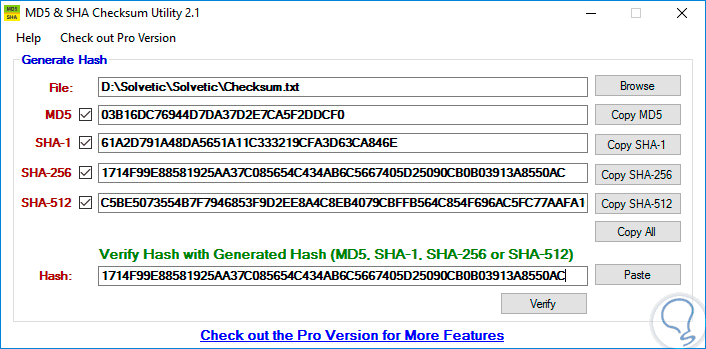

We can use a combination of the three methods to verify if our file is intact: There are cases when you need to compare the files across systems, specially when they are transferred from one location to the other.
.png)
We can use the same method to compare files with the same name, size, and modification time across different machines to ensure that both files are the same. Now we know that the file has changed as the checksum hash values are no longer the same. The first column is the hash value and it has changed since we appended the text. Let's calculate the checksum again and see if the hash value has changed: cksum calculator.py Let's modify our original file calculator.py by adding an extra line at the end: echo > "this file is now changed" > calculator.py Let's see how that looks with an example.

The second value is the amount of data in bytes for the given file.Įven a slight modification changes the hash value.SHA-256 hashes used properly can confirm both file integrity and authenticity.
LINUX SHA256 CHECKSUM ISO
We can calculate its checksum like this: cksum calculator.py sha256sum on Linux Check the iso file Check the CD digest (1) on Solaris SHA256SUM of burnt media External Links The program sha256sum is designed to verify data integrity using the SHA-256 (SHA-2 family with a digest length of 256 bits). Let's suppose we have a file named calculator.py.
LINUX SHA256 CHECKSUM HOW TO
The basic syntax is as follows: cksum How to Use cksum The cksum command takes the filename as an argument and generates its hash value. To learn more about the CRC algorithm, refer to this page. How to Find the Checksum in Linux using cksumĬksum is a command found in *nix-like operating systems that generates a checksum value for a file or stream of data.Īccording to the man page of cksum, the command prints CRC (cyclic redundancy check) checksum and byte counts of each FILE. Next we will see how we can calculate the hash in Linux. Some commonly used cryptographic hash functions include MD5 and SHA-1. If the hash value is same, it implies that your copy of the file is genuine and error free. In networking, you can use checksum to compare the hash value at sender and receiver ends. It's applied to blocks of the data in the file. To ensure that the data remains consistent, we can use checksum.Ĭhecksum is the result of an algorithm called a cryptographic hash function.

Sometimes the data gets corrupted during transmission or storage. The method is called 'checksum' and the corresponding command for that in Linux is cksum. The methods mentioned above usually get the task done, but there is an advanced method to check file integrity using a hash. rw-r-r- 1 zaira zaira 263 Jul 19 13:22 calculator.py File size is 263 bytes The 5th column shows the size of the file in bytes. We can view the file size using long listing( ls -l). If we know the previous size of the file, we can compare it with the current file size to see if was changed. rw-r-r- 1 zaira zaira 263 Jul 19 13:22 calculator.py File modification time is Jul 19 13:22 How to Check if a File Was Modified by Checking File Size In the output below, we can see that the file was modified on Jul 19 13:22. We can view the last modified time of a file using long listing( ls -l). When a file is edited, its timestamp changes to match the modification time. In case you need to check if file was modified, you can follow these two approaches: How to Check if a File Was Modified by Checking Modification Time Linux has a powerful command line which allows you to explore multiple aspects of files and filesystems.
LINUX SHA256 CHECKSUM INSTALL
But, on Windows 7, you’ll have to install the PowerShell 4.0 update to get it.When you are working with files on the command line, you might need to check their modification time and content integrity. Update: Get-FileHash is included with Windows 10. On Windows 10, right-click the Start button and select “Windows PowerShell.” You can also launch it by searching the Start menu for “PowerShell” and clicking the “Windows PowerShell” shortcut. On Windows, PowerShell’s Get-FileHash command calculates the checksum of a file. RELATED: What Are MD5, SHA-1, and SHA-256 Hashes, and How Do I Check Them? You don’t need any third-party utilities. Windows, macOS, and Linux all have built-in utilities for generating checksums. If you know the checksum of an original file and want to check it on your PC, you can do so easily. RELATED: What Is SHAttered? SHA-1 Collision Attacks, Explained How to Calculate Checksums If you only know the MD5 sum of an original file, you must calculate your copy’s MD5 sum to check if it’s a match. A file will have different MD5, SHA-1, and SHA–256 checksums. Different checksum algorithms produce different results.


 0 kommentar(er)
0 kommentar(er)
